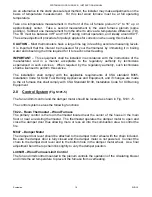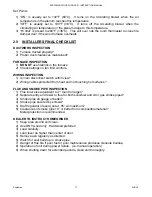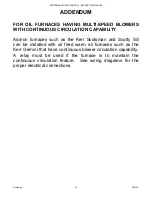
SCOTSMAN WOOD FURNACE – INSTRUCTION MANUAL
Scotsman
Jun
-10
4
CREOSOTE
Wood combustion is never 100% complete. Wood smoke always contains some unburned
gases and a mixture of unburned tar-like liquids. A percentage of these materials will
condense out on any cool surface, leaving a dark brown or black substance with an unpleasant
acrid odor. This substance is commonly called creosote.
If these wood gases condense out on cool surfaces such as a cold chimney or a long smoke
pipe, they retain large amounts of water and will be very fluid. At higher temperatures the
condensed creosote will resemble tar (thick and tacky).
Creosote generation is highest during low heat outputs common with long smoldering burns.
Creosote generation is lowest during high heat outputs common with intense fires. It is
recommended that a small intense fire be used for best results against creosote build up even
though the wood furnace will require refueling more often.
Creosote generation is also higher when burning green wood. The moisture in the green wood
absorbs the heat from the fire, cooling the fire below the point at which the creosote can be
consumed. The low temperature smoke is then further cooled in the upper furnace chambers;
smoke pipe and chimney allowing large amounts of creosote to form.
To reduce creosote build-up during periods of low heat requirements (i.e. Spring and Fall) it is
recommended to fuel the wood furnace with smaller quantities of smaller diameter logs.
Matching fuel loads and heat requirements will result in cleaner combustion and higher
efficiency.
IN CASE A SERIOUS CREOSOTE FIRE BEGINS:
o
Close the damper door by disconnecting chain.
o
Close all draft regulators.
o
Throw 1/2 lb. of coarse or table salt on the fire and close door immediately.
o
Call the FIRE DEPARTMENT at once!
Have a firmly established Emergency Procedure in place for the handling of a flue fire.
1.3 STORAGE
OF
WOOD
Once cut, green wood dries (or seasons), quickly at first and then at a slower and slower rate.
When the wood has been cut to the proper length and split, it should be piled outside during
the summer months. Place two poles on the ground to serve as rails to keep the firewood off
the moist ground. Stack the wood so that both ends of the logs are exposed to the air if space
is available, since more drying occurs through the cut ends than through the sides. This is true
even with wood that has been split. The woodpile should be under cover so that it will not
absorb moisture from the rain and snow before it is used, but still open on the sides and ends
to the drying effect of the wind and sun. Store wood in neat well supported piles.
Содержание DB-101
Страница 20: ......
Страница 21: ......
Страница 22: ......
Страница 23: ......
Страница 24: ......
Страница 25: ......
Страница 26: ......
Страница 27: ......
Страница 28: ......
Страница 29: ......
Страница 30: ......
Страница 31: ......
Страница 32: ......
Страница 33: ......
Страница 34: ......
Страница 35: ......
Страница 36: ......




















